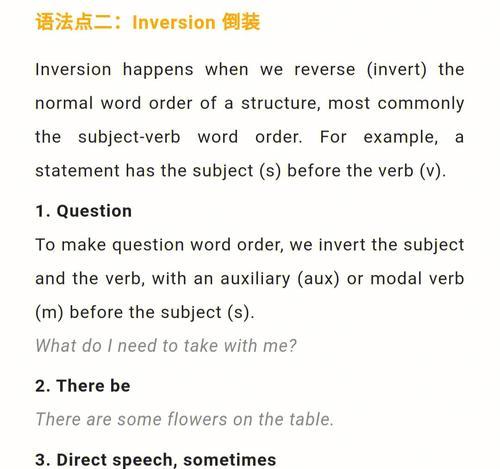高中英语语法中的倒装是一个重要概念,包括完全倒装和部分倒装。完全倒装是将谓语动词放在主语之前,常见于否定副词、"Here或There+be动词"、"Only+状语"和"Not until+状语"等情况。部分倒装是将助动词或情态动词放在主语之前,常见于否定词、连接词和"only when, only if, only after, only in this way"等状语开头的句子中。通过学习这两种语法形式,可以更好地理解和运用英语句子结构。

完全倒装
完全倒装是指将谓语动词放在主语之前。这种倒装方式通常用于以下几个情况:
-
在句首置入否定副词“No, Not, Never, Little, Seldom, Hardly, Rarely”等时,需要完全倒装。例如:Never have I seen such a beautiful sunset.
-
在表示“Here或There+be动词”时,需要完全倒装。例如:Here comes the bus.
-
在表示“Only+状语”时,需要完全倒装。例如:Only in this way can we solve the problem.
-
在“Not until+状语”时,需要完全倒装。例如:Not until he left did I realize that I loved him.
部分倒装
部分倒装是指将助动词或情态动词放在主语之前,而将主语和其它动词保持原来的位置。这种倒装方式通常用于以下几个情况:
-
在以“never, hardly, seldom, little, not, nor, no sooner, in vain”等否定词开头的句子中,需要部分倒装。例如:He seldom goes to the cinema on weekdays.
-
在以“so, neither, nor, such, as well as”等连接词引导的句子中,需要部分倒装。例如:So great was his excitement that he couldn't sleep all night.
-
在以“only when, only if, only after, only in this way”等状语开头的句子中,需要部分倒装。例如:Only when he arrived did I start to cook dinner.

